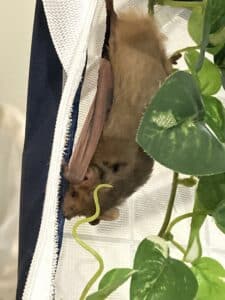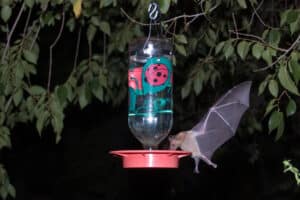Imagine a beautiful night of stargazing when suddenly you feel the whoosh of wings over your head. High-pitched clicking sounds come from above, and a small, winged mammal darts around in the light of the moon as it catches insects. You’ve just been lucky enough to witness nature’s pest control: a bat!
Thanks to this tiny, highly-adapted echolocator, there are fewer mosquitoes transmitting diseases. Bats have long been vilified as “evil, blood-sucking creatures of the night,” largely due to their association with vampires; and their nocturnal nature. Unfortunately, this reputation makes their conservation that much more difficult. In reality, bats are small, scared animals that are just trying to survive. The imagery of bats baring their fangs only increases human fear of these mammals, but these images are just examples of fearful bats being improperly handled, and their only form of self-defence against large humans is their teeth. Luckily, some examples of amazing bat conservation measures that are already working well include bat boxes, planting native plants, education, and research, all of which are causes for celebration!
I volunteer with a local wildlife rehabilitation group called Project Wildlife in San Diego, CA where twenty-three bat species within the county are negatively affected by urbanization. These species face threats such as glue traps, wind turbine collisions, artificial lighting, habitat loss and fragmentation, and general human disturbance. I have had experiences with native bats in field research and rehabilitation and have witnessed their amazing adaptations and ecological benefits firsthand! It was through Project Wildlife that I had my first up-close experience with a tiny Western Yellow Bat (Lasiurus xanthinus), named Lasiurus. He was found struggling in a swimming pool and was lucky enough to receive rehabilitation. Unfortunately, the injuries to his thumbs were too extensive, and he was deemed unable to be released. Now, he is an education animal ambassador and gets to show people how cute and amazing bats are.

Laurius. Photo by Caitlin Dicarlo
I will never forget his soft blonde fur, tiny adorable face, pointy ears, and amazingly delicate yet strong transparent wings. I learned that yellow bats roost under dead fronds of palm trees. If you have a palm tree in your yard, consider keeping the dead fronds attached to the tree as a habitat for bats. Now I don’t know about you, but for me, the image of a tiny, fuzzy-winged mammal snuggled up underneath a palm frond is too cute to handle!
And just like that, I was in love. I had always been interested in uniquely adapted animals, but the more I learned about the Chiroptera order (meaning “hand wing”), the more I fell for them. My first rehab bat was a Big Brown Bat (Eptesicus fuscus) named Bruiser. Big Brown Bats look like miniature werewolves with wings. Bruiser purrs when he is happy. Yes, you read that right-bats purr by vibrating their whole bodies when happy, like itty bitty flying kitties!

Bruiser. Photo by Caitlin Dicarlo
If all of that cuteness isn’t enough to convince you of their charms, let’s dive into the benefits bats provide to us and our ecosystems. Most bat species in San Diego are insectivores, meaning they live off of flying insects like moths and mosquitoes. There are a few species that are nectarivorous, meaning they feed on plant nectar of native endangered flora like the Shaw’s Agave. These species also help to pollinate important plants that produce chocolate, bananas and tequila to name a few. Nationally, bats save the agricultural system 3 billion per year in pest control and pollination (usgs.gov, 2023).

Mexican Long-Tongued Bat. Photo by Ken Bosma licensed under CC BY 2.0
Groups like Project Wildlife, Bat Conservation International (BCI), and the North American Bat Conservation Alliance (NABCA) are leading the way in research and outreach to help these nocturnal animals. BCI conducts white-nose syndrome surveillance to improve the survival rate of bats, research to decrease fatalities, and awards scholarships to support students. NABCA promotes and facilitates communication between governments, researchers, and communities to increase protections for bats.
If you’d like to be a buddy to bats, consider creating a bat-friendly yard or balcony at your house. Even the smallest outdoor space can provide shelter, water and food. Plant native night-blooming flowering plants that attract moths, and avoid using pesticides. Maintain any dead or alive trees on your property which provide natural homes for native bats. Keep your cats indoors and turn off your outdoor lights at night. Provide a water trough or pond with logs for them to crawl out if they fall in, and get or make a bat box (batcon.org, 2023). With enough people taking these measures, we can ensure the long-term survival of these important species, their habitats and other wildlife.
References:
- N.A. How to attract bats to your backyard. (2023). Bat Conservation International. https://www.batcon.org/about-bats/bat-gardens-houses/.
- N.A. (2023). Why are bats important? (Accessed 2023, March 3rd). USGS. https://www.usgs.gov/faqs/why-are-bats-important.


